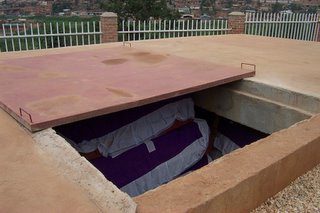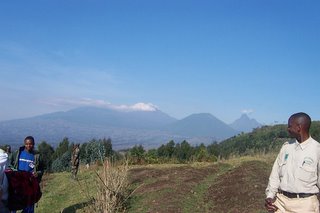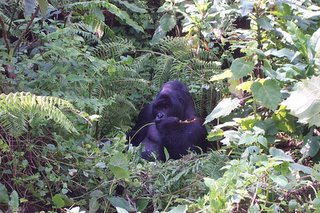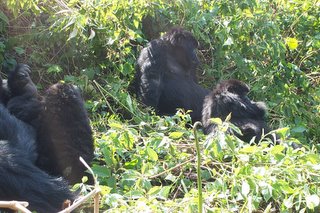 We flew to Kigali, Rawanda, and the first thing they did was take us to the Memorial Museum. There are still unclaimed bodies, they suspect because there is no one left in the family. This coffin contains a woman named Denise Ururu. I know nothing about her, not her age, her marital status, or whether she was a mother, a daughter, or someone's best friend, but I memorized her name and promised myself I will think of her occasionally for the rest of my life, just so someone will know she lived. They did not allow cameras in the museum, and trust me when I say it was incredibly difficult to walk through, especially the huge pile of skulls, mostly babies', split open by machetes. The hope is that by showing this to the Rawandans -- and all schoolchildren come here at least once -- they can break the cycle of senseless hatred.
We flew to Kigali, Rawanda, and the first thing they did was take us to the Memorial Museum. There are still unclaimed bodies, they suspect because there is no one left in the family. This coffin contains a woman named Denise Ururu. I know nothing about her, not her age, her marital status, or whether she was a mother, a daughter, or someone's best friend, but I memorized her name and promised myself I will think of her occasionally for the rest of my life, just so someone will know she lived. They did not allow cameras in the museum, and trust me when I say it was incredibly difficult to walk through, especially the huge pile of skulls, mostly babies', split open by machetes. The hope is that by showing this to the Rawandans -- and all schoolchildren come here at least once -- they can break the cycle of senseless hatred.
From Kigali, we drove out in the country, to the Gorilla Mist Lodge. Accomodations were pretty spotty, with no hot water most of the time, but when you learn that there are women who walk six miles a day to get drinking water, you don't complain much about missing a shower.
 This was our starting point. The mountains are actually in Uganda, and Diane Fosse is buried, with Digit, in the valley between the the peaks. We had our regular guide, two guides who worked for the park, and four soldiers with us. The official explanation was that the soldiers were there in case of poachers, but our guide told us later that there are 4000 of theTutsi murderers still in Uganda, and the soldiers are there in case some of them try to sneak back into Rawanda. (They are putting them on trial, not trying to kill them.)
This was our starting point. The mountains are actually in Uganda, and Diane Fosse is buried, with Digit, in the valley between the the peaks. We had our regular guide, two guides who worked for the park, and four soldiers with us. The official explanation was that the soldiers were there in case of poachers, but our guide told us later that there are 4000 of theTutsi murderers still in Uganda, and the soldiers are there in case some of them try to sneak back into Rawanda. (They are putting them on trial, not trying to kill them.)
We were a group of eight, and there were four groups, each tracking a different family. We were extremely fortunate to track two families who lived relatively low on the mountain, and both days we got to spend an hour observing. Some people climb for hours, and never see the gorillas.

We began the climb here. You see that little opening? That's as good as the trail ever got. The guides had machetes and hacked their way through the jungle. We climbed for about an hour, and suddenly I caught wind of something unpleasant. Now the use of deodorant in Africa does not seem to be widespread, but what went through my mind was, boy, this soldier is really rank. That thought was quickly replaced by, oh wow, I know that smell, that's a gorilla!

And there he was. Gorilla families get up about 8:00 AM, spend a couple of hours eating (their favorite food is nettles) and then come together about 10:00 for some family time. We timed it perfectly.

There was a pair of twins about a year old, and a juvenile about three. They were scampering around playing and making a racket. The silverback very deliberately got up and walked over to them. We figured he was probably going to cuff them and stop all the noise. Instead, he lay down on his back and proceeded to play-wrestle with them for several minutes. I'm sorry I can't post a good picture of it, but it was all legs and arms, and you really can't tell what's what in the pictures. The little ones would climb up on his belly, he would push them off gently while growling very softly. A few times he lifted one of them up in the air with his feet. I promise you -- the Professor is my witness -- he gave one of them a noogie. It was exactly like a man playing with his children. Mama, meanwhile, sat off to one side with one of the other children.

You are supposed to stay ten meters from the gorillas -- for their protection, as they can pick up human germs -- but you are in a jungle, with very little room to manuever, and the gorillas are moving around. At times we could have reached out and touched them. They know the guides, who make a sort of throat-clearing noise periodically, which the gorillas answer in kind. This apparently means Hey, everything's cool, man. You have to turn off the flash on your camera, you can't make any sudden moves or loud noises, and they ask you not to make the trek if you have a cold. You get one hour from the time you encounter them until you have to leave. Apparently gorillas have a good sense of time, because almost exactly to the hour, the silverback stood up, beat his chest, and charged us. We were in no danger; he veered off well before he got to us. He was just letting us know that we were starting to annoy him.

On our second day, I was walking through the bamboo when the guide suddenly knocked me to the ground. He had his hand around my neck, and as he scooted forward, he dragged me along with him. I had no idea what was happening! But a gorilla had decided he wanted to walk in the exact spot where I had been standing, so the guide knocked me down and then pushed the gorilla over a little bit. The Professor was filming the gorilla, but missed the part the guide played, so on videotape it looks exactly like the gorilla knocked me down. I managed to get to my feet in time to get this shot of his retreating back.
Here are the children who live at the bottom of the mountain. They are old enough to be in school, but their work is needed by their families. The boys tend the goats; the girls take care of the babies. The girl in green has a one-month-old tied on her back; the one in blue has an 18-month-old on hers. Along the road through town, the children line up to beg for water bottles. This was a hard lesson for a bleeding heart like me: you have empty plastic water bottles, they can use these bottles so they will have something to drink while they are in the fields; what better win-win scenario can you imagine? Well, it doesn't work. They cut school to beg for the bottles, which have some monetary value. One afternoon we started waving to the children who were begging, and soon it became almost a mission. For an hour we waved to everyone we saw -- big, full-armed waves, not Queen Elizabeth's screwing-in-a-lightbulb kind. Almost everyone we saw smiled and waved back. Women in their fields would drop the hoe and wave back with both arms. By the time we got back to the lodge, our arms were sore, but our hearts were overflowing.













5 Comments:
What an amazing experience. You are a braver woman than I. You should write a book about your travels. You tell the story beautifully.
Wow.
You DO tell the story beautifully! How incredible that you were so close to the Gorillas...I didn't realize that they would allow people to come so close to them. Amazing.
it's kind of sad that those young kids have that much responsibility, but i guess that's the way it is over there, and you're way, way, way, way, to close to some of those animals.
oh thank you so much for this entire post. the museum, the gorillas, the children.
incredibly stunning of you to remember Denise Ururu.
i only wish i could afford to go see the gorillas ... how amazing that must have been.
wow, what a treat!
Post a Comment
<< Home